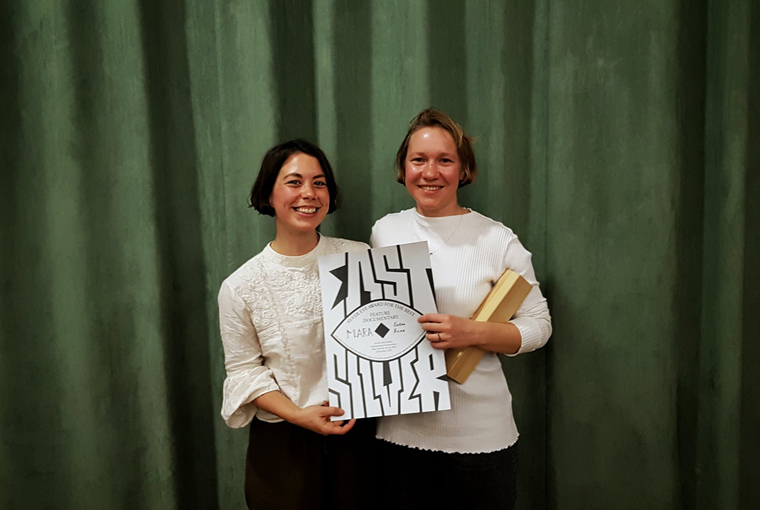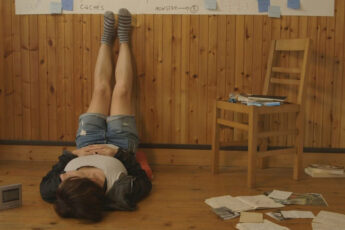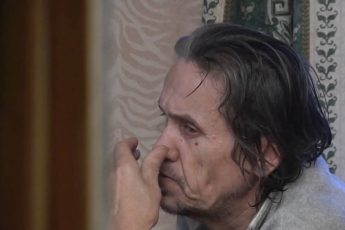
We met Sasha Kulak (pictured on the right) at the goEast film festival in Wiesbaden (April 19-25), where her film Mara, a personal story of revolt and resistance shot during the Belarusian protests of 2020-2021, screened in the main competition. Kulak discusses the context of her film, the unique feeling of living through one of the most important moments of contemporary Belarus, and her choice to avoid a typical documentary format.
Your film Mara documents events that took place during the 2020-2021 Belarusian protests. We see peaceful crowds, in this case mostly women, facing large swathes of all-male, anti-riot police, images that sadly resonate across Europe, for instance France as it was shook up by the Yellow Vests protests. Could you share something about the political background against which the events in the film unfold?
I didn’t want to make a typical “reportage” film. For me the most important thing was to show what trauma does to the human psyche. I wanted to make a film that can be related to any similar event. In any kind of violent event, people go through similar experiences. There is a feeling of dissociation, as if you observed reality from afar and lost the connection to your physical body. Not including the specific context was an intentional choice, so that someone who hasn’t heard of the specific protests happening in Belarus could still understand how it feels to live in constant fear. And then if someone is interested, they can google more information, since there are tons of videos and articles online.
As for the first part of your question, this kind of grip and the presence of police is a sign of an authoritarian regime, and in ex-Soviet countries this is a heritage of the Soviet Union. Excluding the Baltic countries, Ukraine is actually the only ex-Soviet country to have shifted to a democratic system. The other countries have more or less totalitarian regimes and depend on Russian politics and economic activities. France is a country where people have the right to protest. That the French are going out on the street is a sign of change. Nothing of the sort has ever happened in Belarus. There is no culture of protest, because the grip of the regime is too tight and people are not used to demonstrating. That is why the 2020 protests are a unique and historic event – it is the first time something of this kind has happened in the modern history of Belarus.
Since you didn’t include any specific context about these protests, the viewers could read the film through their personal experiences and were invited to see the film more as a personal testimony and less as a film conveying factual information and statistics.
Yes, when I think about making a film, I try to imagine an alien approaching this situation, knowing nothing about the time or place. What you can see with your own eyes and what you can experience with your own body are the only sources of information I want to provide viewers with. When you read newspapers you can get different kinds of information, but it is also very easy to get lost. In a way, through my approach I wanted to show how someone can make sense of a situation through what they can experience with their body and mind.
To provide some context, Alexander Lukashenko, the president of Belarus, has been in power since 1994, and I don’t consider his presidency legitimate. Usually, when elections approach, the candidates favored by the people are arrested because the government wants to avoid a fair election. This is what happened in 2020. Sviatlana Tsikhanouskaya is today the leader of a protest movement and our chosen president, yet she lives in exile. Her husband, Sergei Tikhanovsky, announced his candidacy in May of that year and was immediately imprisoned. Given the political climate, people started gathering and organizing protests even before the elections.
Another thing is that the Belarusian authorities were trying to outright deny the existence of Covid 19. As people were getting sick and dying, the most bizarre things would be stated on national television. For instance, Lukashenko said that the virus doesn’t exist and that the people who are dying are fat or sick so that they should simply take better care of their health and drink some vodka. That angered people, including those who were not into politics. Their dear ones were dying and hospitals explained it as a heart attack or pneumonia. To counter this atmosphere of denial, people started to organize via Telegram to collect money and medical equipment since doctors were working under inhumane conditions. When people started uniting, they realized that they were not alone: perhaps ninety per cent of the population were already opposed to the existing government. When Sviatlana Tsikhanouskaya’s husband went to prison, she submitted her own candidacy and Lukashenko made a sexist comment about her on national television, saying that she was just a “housewife”.
From your film we get the impression that mostly women gathered to protest. Was that really the case, or was it your choice to focus on them?
That’s a good question. I didn’t notice it when I was there, nor as I was editing. In a first cut, I had included audio recordings of people who were tortured during the first days of the protests. So, the first version of the film had these voice recordings, including male ones, describing similar situations. But watching that first version, I realized that indeed this movement had a female voice and face, so I decided to get rid of these voice recordings and keep the images from the streets. Of course, there was some footage featuring men, but they were less active, for which one can cite two reasons I believe. Firstly, policemen tend to be more violent against men, because there is this stereotype where the worst thing you can possibly do is “beat up a woman”. Of course, while they were less violent towards women at first, they ended up beating everyone. Either way, men were therefore more scared and maybe women were also asking their male partners not to participate in the protests. Secondly, I noticed that in Russia most of the anti-war movements are also led by women today, and so I started wondering, “why do we see women everywhere, where are the men?” And I thought that, since Belarus is pretty much a patriarchal society and women face injustice much more often than men do, they have become more sensitive and attentive towards any kind of injustice. Women feel the injustice and want to change it, because they have firsthand experience in their everyday life, and they know what it means to be oppressed. This is just my subjective interpretation, maybe there are other reasons.
During a protest, the role of a video journalist is to record how events unfold and document transgressions by the police. You did something different. While we see the general ambiance inside the protests, you remain playful and personal. Would you say that cinema has a specific role to play during social movements?
When I first participated in the protests, I was not planning to make a film. Before the protests, I was actually in the north of Russia working on an ethnographic project. When the protests started, I felt a “calling” for the first time in my life that made me want to abandon everything and just go back. So, I contacted some media outlets and asked them if they needed someone to gather footage, to film the protests. I was already a week late and at that time many journalists were already arrested or deported to Russia and most of the media could no longer get accreditation to cover the protests. A radio station asked me to help with their coverage since three of their journalists had been deported. The day I arrived, I started filming the leader of the workers’ strike, who was detained by the police in front of me. I kept filming his wife and other people from the factory and I helped them organize a press conference. I was basically doing anything I could. After two weeks, I felt that there was enough material online to make a brilliant film out of the footage random people shot. People would publish videos of all kinds of bizarre things. Like videos of people trying to escape orc-like policemen running after them. Or that of a taxi driver who enters a street vertically so someone can hop in and they can drive away. These were scenes that looked as if they had been taken out of a blockbuster movie. Another video showed a fire engine spraying the crowd, coloring them with orange paint, which looked very surreal.
However, while the media were already showing typical documentaries with interviews from the activists and the leaders of the protests, there was nothing about this feeling of dissociation everyone shared, about how the mindset had shifted at a certain moment. I would hear everyone say that they couldn’t sleep or had nightmares because of how shocking and surreal these days had been. This feeling was everywhere, and it was perhaps more important because it was collectively shared. Unlike typical documentaries, I tend to make hybrid films to combine different narratives, and I started thinking that it would be interesting to convey that feeling. Usually, we open a YouTube video and it starts with a very “catchy” violent scene, so we immediately understand the context, and then we stop feeling shocked by the degree of violence we witness. We just think, “okay, another person was killed.” It is normalized. I wanted to avoid that, and that’s why the film starts very slowly, gradually gravitating towards the kind of fear shared by everyone, at least among those who believed in the dream which then become a nightmare.
The film starts with children invoking the Red Queen, so the audience sees fiction as the film’s starting point. And then the reality of the protests kicks in. What is the place of myths and fiction inside social movements? You seem to suggest that there is a connection. Why did you think it was necessary to pass through a myth?
It’s a good a question. I cannot answer for others, but it was a kind of challenge for me. I was facing a historical event and my original mission was to film the protests for the media. But it was my personal intention to make something different, something that could also be understood by a Western audience. I have traveled to different places, places in Asia, South America, the States, and usually when people ask me where I come from, they either don’t know that Belarus exists, or they ask if it is a part of Russia. So, I thought that I should make the context understandable even for people who know nothing about Belarus. But I didn’t want to start with an interview or a disclaimer and so I thought that myths are something everyone can relate to.
Theater is also a central element in your film. Your protagonist, Iryna, has a mask and a costume and one of the most important testimonies, coming from a girl beaten up by the police, is staged as a theater scene. Is there a connection between theater and social truth? Do you consider theater to be a place where truth can be exposed to the public eye?
Like mythology, theater is something understood by different cultures, so this was one of the reasons for this choice. When I received the contact of this girl who wanted to give her testimony a couple of months after the event, I immediately imagined the scene. The Red Queen embodies a common female voice for me, she represents all women and their voices. I therefore imagined a scene where Anna, the real person who was tortured, shares her story dressed up in the same way as Iryna, to create this common voice. The Queen is a guide absorbing all stories, including the one Anna describes. But perhaps you understood it in a different way, and I am interested in different readings.
You also said that it would be difficult to screen Mara in Belarus, since there’s a risk involved. The film ended on a pessimistic note, with your main character saying that “we are all prisoners in this society”, yet at the same time the film suggests that we can move beyond that. What kind of hopes and aspirations do you have for this film, and what kind of audience would you like it to reach?
There are changes that already happened in Belarus, and this is also mentioned when the main character says that “the best future has already happened inside us” at the end. Actually, the film ended differently in a previous version of the film. There used to be this choir gathering every day to sing a song about freedom in different places by a collective called “The Free Chorus”. I contacted them to learn the place of their next performance and filmed them. It was not a cinematic place, just a mall, but since the chorus occupied all floors and thus appeared to sing from everywhere, the sequence had an optimistic undertone. I kept this ending until last summer, when it became obvious that changes would need to wait, that they would not happen in the next months or perhaps even year. We started with hope, but progressively we were left with fear and disappointment.
We still treasure this moment of the nation reuniting because, before these events, people were separated from each other. You were in a situation where you wouldn’t really trust your neighbors because they would maybe be pro-government, and after the events it became obvious that most people were allies. I also remember saying to my producer that I was not sure why such a film should exist, because it looks like a horror film. You came to the cinema, you watch this film and you come out depressed, so why should it exist? And he replied that horrors exist, and that people love to watch them in cinema halls. So, I was convinced, but it was a very difficult decision for me because I really didn’t want to make a pessimistic film. On the other hand, I wanted to be honest. As for the audience, it is impossible to screen the film in Belarus because there’s no art space infrastructure left anymore. We didn’t plan to have a screening in Russia, because even though this is not investigative journalism, there is still a small chance to attract unwanted attention. We did have a secret screening in Moscow with 70 people though. As with any kind of film, what you want to do is share some knowledge – films have this educative dimension – and show the film to people who are interested.
Thank you for the interview.




Leave a Comment